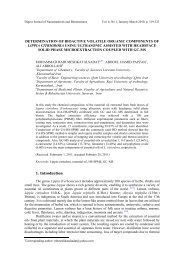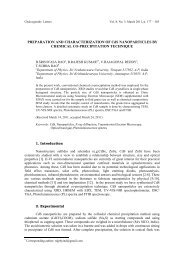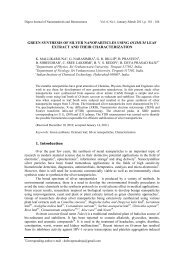Jia Guo-Zhi, Fei Xue-ning, Wang Jun
Jia Guo-Zhi, Fei Xue-ning, Wang Jun
Jia Guo-Zhi, Fei Xue-ning, Wang Jun
You also want an ePaper? Increase the reach of your titles
YUMPU automatically turns print PDFs into web optimized ePapers that Google loves.
Chalcogenide Letters Vol. 7, No. 3, March 2010, p. 181 - 185<br />
SYNTHESIS OF WATER DISPERSED CdSe/ZnSe TYPE-II CORE-SHELL<br />
STRUCTURE QUANTUM DOTS<br />
JIA GUO-ZHI ∗ , FEI XUE-NING, WANG JUN<br />
Tianjin Institute of Urban Construction, Tianjin 300384, China<br />
CdSe/ZnSe core/shell type-Ⅱ structure quantum dots were prepared by a one-pot synthesis<br />
based on a simple solution route. The samples were characterised by UV-Vis spectroscopy<br />
and PL spectra. The influence of the reaction time on the optical properties of quantum<br />
dots was studied in detail, and the result indicated that reaction time plays an important<br />
role in the formation of CdSe/ZnSe type-Ⅱ quantum dots.The dependence of Cd 2+ /Zn 2+<br />
ratio on the formation of CdSe/ZnSe type-Ⅱ quantum dots was investigated, too. This<br />
result clearly indicates that the Cd 2+ is considerably more reactive than Zn 2+ toward<br />
NaHSe, which can indicate that the Zn 2+ concentration can influence the formation rate of<br />
CdSe due to the increasing of Cd 2+ releasing rate.<br />
(Received January 22, 2010; accepted March 1, 2010)<br />
Keywords: CdSe/ZnSe; quantum dots; core/shell structure; type-Ⅱ structure.<br />
1.Introduction<br />
Colloidal semiconductor nanocrystals quantum dots have attracted great fundamental and<br />
technical interest because of their unique optical and electronic properties, such as photoblenching<br />
stability, continuous absorption band, narrow photoemission, strong fluorescence, broad<br />
photoexcitation [1]. As already known, semiconductor heterostructures are typically classified as<br />
type-I or type-II. In the type-I structure, the electron and hole can localize the area of core because<br />
both the conduction and the valence band edges of the core are located within the energy gap of<br />
the shell [2,3]. As far as type-astructure is concerned, both conduction and valence bands of core<br />
are either lower or higher than those in the shell. The type-I structure core-shell quantum dots has<br />
some unique advantages over type- �structure quantum dots. First, the carrier can effectively<br />
separate on different areas in the core/shell quantum dots. Second, the emission wavelength of the<br />
type-I core-shell quantum dots can be longer than the band gap of either the core or the shell<br />
material due to spatially indirect transitions [4]. Finally, the type-II structure can greatly prolong<br />
the lifetime of photoexcited carriers [5].<br />
According to an investigation by Balent et al.[3], it was found that ZnSe/CdSe core/shell<br />
nanocrystals can exhibit either type-I or type-II behaviors with the changing of the core radius and<br />
the shell thickness. Therefore, more efforts have been transferred to synthesis and tunable optical<br />
properties by combi<strong>ning</strong> the different materials to forming the type-I structure quantum dots [6-8].<br />
David, et al. experimentally investigated the carrier multiplication in type II CdTe/CdSe quantum<br />
dots heterostructures [8]. Unfortunately, very little research has been found on the synthesis of<br />
CdSe/ZnSe core/shell quantum dots by the water-based method for application in biological<br />
imaging. In this paper, we discuss the dependent of Cd 2+ /Zn 2+ ratio on the formation of CdSe/ZnSe<br />
type- �quantum dots.<br />
2. Experiments<br />
All chemicals were used without further purification. Tellurium power (99.9%), CdCl2<br />
∗ Corresponding author: dip-coating@163.com (JIA <strong>Guo</strong>-zhi).
182<br />
(99.9%), and thioglycolic acid (98%) were purchased from Tianjin Chemical Reagents Company.<br />
Distilled water was used throughout. Sodium borohydride was reacted with selenium powder in<br />
distilled water to form the Se 2- precursors. The molar ratios of Zn 2+ /Cd 2+ in mixed solution are 9:1<br />
and 8.5:1.5, in sequence. The water-soluble CdSe/ZnSe core/shell quantum dots were synthesized<br />
by using thioglycolic acid as stabilizer in aqueous solution with N2 protection.<br />
All photoluminescence (PL) spectra were recorded on a Cary Eclipse. The excitation<br />
wavelength was fixed at 338 nm, the emission spectra were recorded between 500 and 800 nm at a<br />
scan rate of 2 nm/s. An excitation and emission bandwidth of 5 nm was used. The UV-vis<br />
absorption spectra of the samples were recorded on a New Century T6 photospectrometer.<br />
3. Results and discussion<br />
The PL spectra of CdSe/ZnSe core/shell quantum dots as a function of the growth time are<br />
reported in Fig.. 1. The Zn 2+ /Cd 2+ ratio was 9:1 in the reaction precursor solution, and the<br />
temperature was maintained at 80℃. As the reaction is processed, the PL intensity decreased, the<br />
emission energy redshifts, which can prove CdSe/ZnSe core/shell quantum dots are formed, while<br />
not CdZnS ternary semiconductor compound. Comparison with the result of Liu. et al. [1], if<br />
CdZnS ternary semiconductor compound nanocrystals are formed, their PL peak position should<br />
be shifted to short wavelengths during the growth process.<br />
Fig.1.The PL spectra of quantum dots with 9:1 Zn 2+ /Cd 2+ ratio, and excited at 350nm. The<br />
peak of PL at 700nm is the second optical overtone.<br />
Fig. 2 shows the optical absorbance recorded at the room temperature for the samples<br />
corresponding to the figure.1. A redshift of the optical absorption edge can be clearly observed<br />
with increasing growth time, which implies the growth of the CdSe. At the same time, an<br />
increasing in the absorbance intensity at the shoulder with the increasing growth time can be found,<br />
which can be ascribed to the growth of CdSe, too.
Fig. 2. Optical absorbance vs. wavelength spectrum for quantum dots samples (Zn 2+ /Cd 2+ moler<br />
ratio as 9:1 in the reaction precursor solution) after different growth time.<br />
The absorption and emission wavelength of the type-Ⅱcore-shell structure quantum dot<br />
depend on the band gap offsets of CdSe and ZnSe. Photon excited electrons and holes can be<br />
efficiently separate due to the formation of the indirect semiconductors, which result in reducing<br />
the electron-hole pair recombination, therefore, the PL intensity decrease with the increasing of the<br />
growth time. As the ZnSe shell thickness is increased, the band gap of offset value can be reduced,<br />
in result, the PL peak position shifted to red.<br />
The quantum dots growth with small Zn 2+ /Cd 2+ ratio has been further studied, while<br />
maintai<strong>ning</strong> the reaction temperature (80℃) and the reaction pH value constant. The PL spectra<br />
for quantum dots sample with 9:1 moler ratio of Zn 2+ /Cd 2+ in the reaction precursor solution are<br />
shown in figure.3. It can be seen that the effect of the growth time on the PL peaks is weak, while<br />
only the intensity of PL increased. This result clearly indicates that the Cd 2+ is considerably more<br />
reactive than Zn 2+ toward NaHSe [1], which can indicate that the Zn 2+ concentration can influence<br />
the formation rate of CdSe due to the increasing of Cd 2+ releasing rate. This is because much thiols<br />
were formed the thiol-metal ion complexes. The reaction between Zn 2+ , Cd 2+ and NaHSe can<br />
mainly depend on the concentration of thiolglycolic acid, the value of pH and Zn 2+ /Cd 2+ ratio et al.<br />
In other words, the composition ratio of Zn 2+ /Cd 2+ in reaction solution is controlled by the<br />
probability for the releasing rate of metal ion and the reactivity between metal ion and NaHSe. As<br />
the Cd 2+ concentration is increased, the reaction mainly happened between Cd 2+ and NaHSe firstly.<br />
Fig. 3. The PL spectra of CdSe/ZnSe with large Zn and Cd ratio (5.8:1.5) excited at 350nm.<br />
The peak of PL at 700nm is the second optical overtone.<br />
183
184<br />
The UV-vis absorption spectrum for samples with different growth time is shown in figure.<br />
4. It can be seen that the absorption peak weakly dependent on the growth time for the large ratio<br />
of Zn 2+ /Cd 2+ (8.5:1.5) in reaction solution. The clear absorption peak at 415nm can be ascribed to<br />
the growth of CdSe. The absorption edges of samples have an evident blueshift at the initial<br />
process and redshift at next growth process. This indicates that a few ZnSe can be formed and<br />
loosely adsorbed on the surface of CdSe core, which can result in quenching the CdSe<br />
nanocrystals emission intensity [9], and shifting the absorption edges to blue. The increasing of the<br />
absorption intensity may be attributed to the increasing of CdSe radius. We have not found that the<br />
absorption peak is different for different QD composition and this indicates that there is no<br />
separated nucleation of ZnSe during the growth process.<br />
Fig. 4. Optical absorbance vs. wavelength spectrum for quantum dots samples (Zn 2+ /Cd 2+<br />
moler ratio as 8.5:1.5 in the reaction precursor solution) after different growth time.<br />
Fig. 5. the PL spectra of ZnSe and ZnSe doping Cd with different Zn and Cd ratio excited<br />
at 350 nm wavelength. The peak of PL at 700 nm is the second optical overtone.
The PL spectra of ZnSe and ZnSe doping Cd with different Zn and Cd ratio excited at<br />
350nm was shown in figure. 5. The peak of PL at 700nm is the second optical overtone. The PL<br />
peak situation of the core/shell structure quantum dots has an evident shift than the pure ZnSe<br />
nanocrystal emission. Additionally, the PL intensity of CdSe/ZnSe quantum dots was superior to<br />
that of ZnSe quantum dots, since the core/shell structure of quantum dots effectively reduce the<br />
number defects on the surfaces of the quantum dots [10]. It can be noted that the small Zn 2+ /Cd 2+<br />
molar ratio in reaction precursor solution would lead to decreasing of luminescence efficiency,<br />
which indicates an optimal Zn 2+ /Cd 2+ molar ratio for CdSe/ZnSe core/shell quantum dots by a<br />
one-pot synthesis based on an solution route.<br />
4. Conclusions<br />
CdSe/ZnSe core/shell type-Ⅱ structure quantum dots were prepared by a one-pot synthesis<br />
based on a simple solution route. The samples were characterised by UV-Vis spectroscopy and PL<br />
spectra. The influence of the reaction time on the optical properties of quantum dots was studied in<br />
detail, and the result indicated that reaction time plays an important role in the formation of<br />
CdSe/ZnSe type- Ⅱ quantum dots.The dependence of Cd 2+ /Zn 2+ ratio on the formation of<br />
CdSe/ZnSe type-Ⅱ quantum dots was investigated, too.<br />
Acknowledgements<br />
This work has been supported in part by the Natural Science Foundation of Tianjin<br />
(09JCYBJC04100) and the Science and Technology Plan Projects of the Ministry of Construction<br />
of China (2008-KT-11).<br />
References<br />
[1] Liu Fang-Chen, Cheng Tian-Lu, Shen Chien-Chih, Tseng Wei-Lung Chiang Michael Y,<br />
Langmuir, 24, 2162 (2008).<br />
[2] S. A. Ivanov, A. Piryatinski, J. Nanda, S. Tretiak, K. Zavadil, W. O. Walalce, D. Werder,<br />
V. I. Klimov, Journal of the American Chemical Society, 129, 11708(2007).<br />
[3] L. P. Balet, S. A. Ivanov, A. Piryatinski, M. Achermann, V. I. Klimov, Nano Letter,<br />
4, 1485(2004).<br />
[4] Sungjee Kim, Brent Fisher, Hans-Jürgen Eisler, and Moungi Bawendi, Journal of the<br />
American Chemical Society, 125, 11466(2003).<br />
[5] <strong>Xue</strong>wen <strong>Wang</strong>, Gang Liu, <strong>Zhi</strong>-Gang Chen, Feng Li, Lianzhou <strong>Wang</strong>, Gao Qing Lu and<br />
Hui-Ming Cheng, Chemical Communications 23, 3452 (2009).<br />
[6] Igor L. Kuskovsky, Y. Gong, G.F. Neumark, M.C. Tamargo, Superlattices and<br />
Microstructures, 47, 87(2010).<br />
[7] P F Gomes, M P F de Godoy, G O Dias, F Iikawa, M J S P Brasil, M A Cotta, J R Madureira,<br />
Journal of Physics D: Applied Physics, 43, 045303 (2006).<br />
[8] David Gachet, Assaf Avidan, Iddo Pinkas, Dan Oron, Nano Letter, 10, 164 (2010).<br />
[9] Renguo Xie, Xiaogang Peng, Journal of the American Chemical Society, 131, 10645(2009).<br />
[10] Y. He, H. T. Lu, L. M. Sai, Y. Y. Su, M. Hu, C. H. Fan, W. Huang, L. H. <strong>Wang</strong>, Adv Mater<br />
20, 3416 (2008).<br />
185










